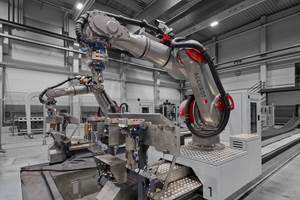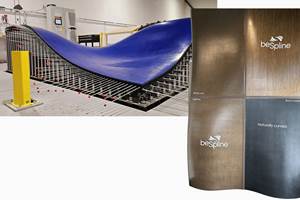Boat builder Lyman-Morse creates aerospace composite prototype
Prototypes for such clients as the Department of Defense and other government and private sector businesses has become an increasingly important segment of the the company’s business plan.
Lyman-Morse Technologies (LMT, Thomaston, ME, US), a division of Lyman-Morse, has recently manufactured a composite aerospace component for a manufacturer of advanced jet aircraft. The component manufactured is a prototype Radome, a thin fiberglass dome that protects and provides aerodynamic fairing over the aircraft’s primary radar usually located in the nose of the aircraft. The LMT Radome was manufactured to extremely rigorous manufacturing standards and tolerances. LMT designed and manufactured the pattern, mold tooling, and fixtures all in-house with existing staff and equipment.
Prototypes for such clients as the Department of Defense and other government and private sector businesses has become an increasingly important segment of the the company’s business plan. Lyman-Morse Boatbuilding is a custom and semi-custom builder of and service provider for sailing and motor yachts. A family run, father and son business, Lyman-Morse specializes in composites, advanced composites and aluminum construction.
Here are the details on the aerospace prototype:
The pattern for the composite mold was machined by Lyman-Morse’s Haas GR 712 precision CNC router. The pattern was machined from stacked and bonded epoxy tooling board which is geometrically stable at the curing temperature of the fiberglass epoxy pre-preg system. The pattern was designed to compensate for thermal growth of the epoxy board as well as the cross link shrinkage of the tooling system. The Haas GR 712 router machined the pattern with minimal offset to compensate for hand finishing. When all was said and done, the pattern was measured to within .001” of the design target, a challenging task for a 19” diameter article.
Cytec’s LTM-16 fiberglass tooling system was selected to fabricate the all composite mold tool. LTM-16 was selected for its low initial cure temperature of 140°F and its ability to remain dimensionally stable at the 280°F (the processing temperature of Park Electro-Chemical’s E-765 7781 fiberglass prepreg system).
E-765 7781 fiberglass prepreg is qualified under AGATE Aerospace Material Qualification Standards for both primary and secondary flight structure components via the FAA. The fiberglass prepreg was laid up in the mold tool utilizing ply patterns and overlaps developed by LMT and approved by the customer. LMT’s laser placement guide was used to ensure all 40 individual plies were placed in exact sequence and position. Environment conditions were monitored and tracked electronically to ensure both temperature and humidity were within prescribed guidelines.
The layup was then cured for 14 hours per the prepreg manufacturer’s recommendations. During that time, four locations on the part and mold tool were tracked and electronically recorded along with the vacuum within the vacuum bag with LMT custom-built temperature/vacuum data recorder. This step was necessary to ensure processing parameters were meet for the AGATE qualified fiberglass prepreg.
The cured part was machined and drilled to the customer’s specifications, with tolerances of +.005”/-.000”. Final quality checks were completed and found within the customer’s requirements. The part was then painted using Aerospace Certified Paints and Primers. The client will use the prototype as a basis for design and manufacturing refinements.
“We have the know-how and experience with the materials, the manufacturing procedures, the brainpower to trouble shoot and problem solve with these companies. A truly satisfying endeavor for all involved,” said Drew Lyman, president of Lyman-Morse.
Related Content
Automated robotic NDT enhances capabilities for composites
Kineco Kaman Composites India uses a bespoke Fill Accubot ultrasonic testing system to boost inspection efficiency and productivity.
Read MorePlant tour: BeSpline/Addcomp, Sherbrooke, QC, Canada
Composites automation specialist increases access to next-gen technologies, including novel AFP systems and unique 3D parts using adaptive molds.
Read MoreAurora reveals latest SPRINT X-Plane design concept
An Aurora and Boeing team advances its high-speed, vertical lift concept to the preliminary design phase, which features three lift fans, a more refined composite exterior and an uncrewed cockpit.
Read MoreActive core molding: A new way to make composite parts
Koridion expandable material is combined with induction-heated molds to make high-quality, complex-shaped parts in minutes with 40% less material and 90% less energy, unlocking new possibilities in design and production.
Read MoreRead Next
“Structured air” TPS safeguards composite structures
Powered by an 85% air/15% pure polyimide aerogel, Blueshift’s novel material system protects structures during transient thermal events from -200°C to beyond 2400°C for rockets, battery boxes and more.
Read MoreDeveloping bonded composite repair for ships, offshore units
Bureau Veritas and industry partners issue guidelines and pave the way for certification via StrengthBond Offshore project.
Read MorePlant tour: Daher Shap’in TechCenter and composites production plant, Saint-Aignan-de-Grandlieu, France
Co-located R&D and production advance OOA thermosets, thermoplastics, welding, recycling and digital technologies for faster processing and certification of lighter, more sustainable composites.
Read More
















.jpg;maxWidth=300;quality=90)








